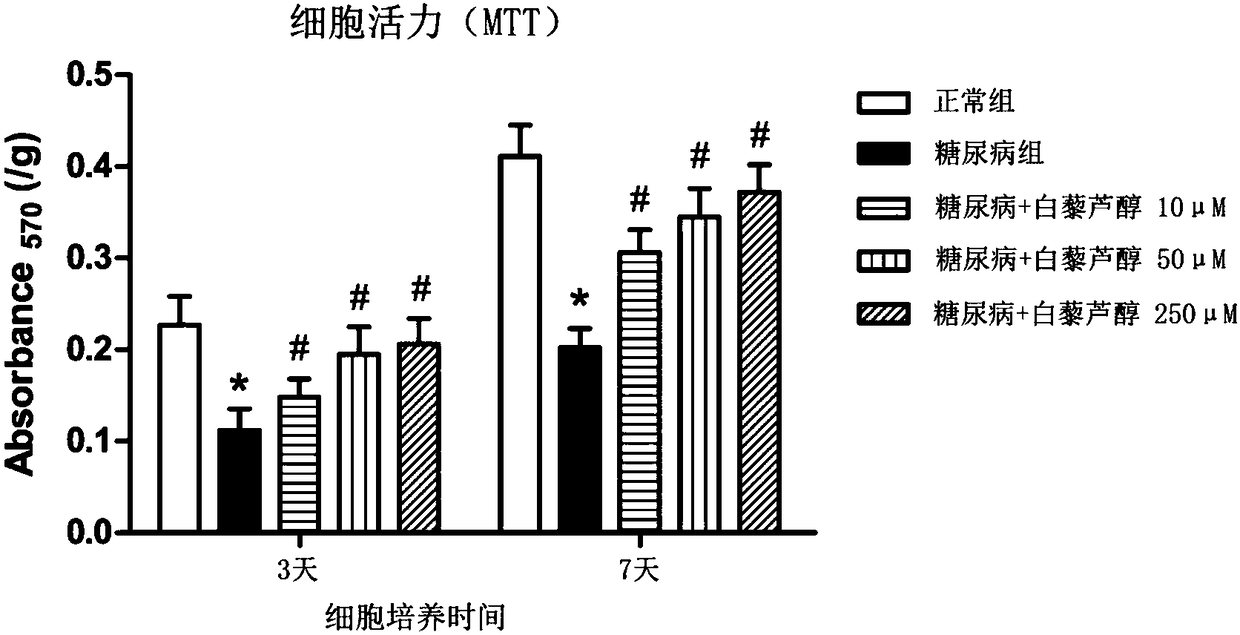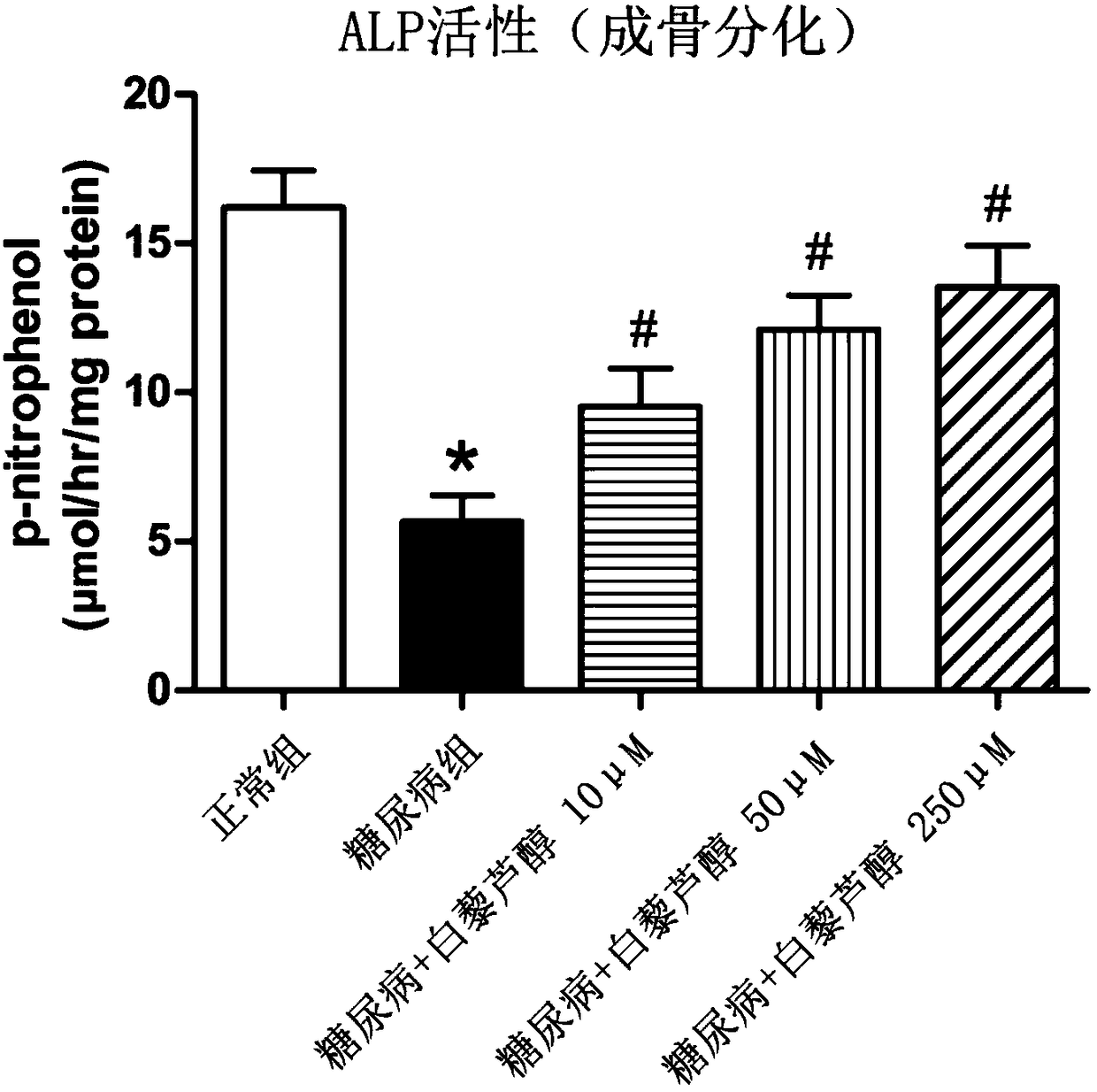Application of resveratrol in medical titanium alloy implants under diabetes conditions
A technology of resveratrol and diabetes, which is applied to the active ingredients of hydroxyl compounds, medical science, bone diseases, etc., can solve the problems of poor osseointegration, cell dysfunction, apoptosis, etc. in titanium alloy implants, and achieve enhanced osteogenic differentiation Efficacy, improvement of adhesion state, improvement of osseointegration effect
- Summary
- Abstract
- Description
- Claims
- Application Information
AI Technical Summary
Problems solved by technology
Method used
Image
Examples
Embodiment 1
[0043] This example shows the application of resveratrol in the preparation of drugs for improving the activity of osteoblasts at the "titanium-bone" interface under diabetes conditions, that is, the effect of resveratrol on osteoblasts on the titanium alloy surface in a diabetic environment Improvement of cell viability.
[0044] Experimental method: cutting medical titanium alloy into titanium sheets, grinding and polishing the surface, cleaning and disinfecting for later use. Osteoblasts from the calvaria of SD rats were isolated and cultured, and were divided into 1×10 4 A cell density per milliliter was seeded on the surface of titanium alloy to establish an in vitro "titanium-bone" interface model.
[0045] Divided into 5 groups:
[0046] 1) normal serum group (normal group);
[0047] 2) diabetes serogroup (diabetes group);
[0048] 3) Diabetes + resveratrol 10μM;
[0049] 4) Diabetes + resveratrol 50μM;
[0050] 5) Diabetes + resveratrol 250 μM.
[0051] The amou...
Embodiment 2
[0055] This example shows the application of resveratrol in the preparation of drugs that enhance the osteogenic differentiation of osteoblasts at the "titanium-bone" interface under diabetes conditions, that is, the effect of resveratrol on osteoblasts on the surface of titanium alloys in a diabetic environment is given. enhancement of osteogenic differentiation.
[0056] Experimental method: divide osteoblasts into 1×10 4 Cells per milliliter were seeded on the surface of titanium alloy for culture, and were divided into 5 groups:
[0057] 1) Normal group;
[0058] 2) Diabetes group;
[0059] 3) Diabetes + resveratrol 10μM;
[0060] 4) Diabetes + resveratrol 50μM;
[0061] 5) Diabetes + resveratrol 250 μM.
[0062] After 7 days of culture, use the ALP enzyme activity detection kit (Sigma company) to detect the degree of osteoblast differentiation on the titanium surface (ALP activity reflects osteogenic differentiation), and operate according to the professional instruc...
Embodiment 3
[0066] This example shows the application of resveratrol in the preparation of drugs to improve the adhesion state of osteoblasts at the "titanium-bone" interface on the material surface under diabetes conditions, that is, the effect of resveratrol on osteoblasts in diabetes environment is given. Improvement of adhesion state and cell proliferation on titanium alloy surface.
[0067] Experimental method: Osteoblasts were inoculated on the surface of titanium alloy for culture, and divided into 5 groups:
[0068] 1) Normal group;
[0069] 2) Diabetes group;
[0070] 3) Diabetes + resveratrol 10μM;
[0071] 4) Diabetes + resveratrol 50μM;
[0072] 5) Diabetes + resveratrol 250 μM.
[0073] The cytoskeleton and nucleus of the osteoblasts were stained with fluorescence after 3 days of culture, and then observed and photographed with a laser confocal microscope. Each group collected pictures on three titanium sheets (the experiment was repeated 3 times), and 6 randomly selecte...
PUM
 Login to View More
Login to View More Abstract
Description
Claims
Application Information
 Login to View More
Login to View More - R&D Engineer
- R&D Manager
- IP Professional
- Industry Leading Data Capabilities
- Powerful AI technology
- Patent DNA Extraction
Browse by: Latest US Patents, China's latest patents, Technical Efficacy Thesaurus, Application Domain, Technology Topic, Popular Technical Reports.
© 2024 PatSnap. All rights reserved.Legal|Privacy policy|Modern Slavery Act Transparency Statement|Sitemap|About US| Contact US: help@patsnap.com










